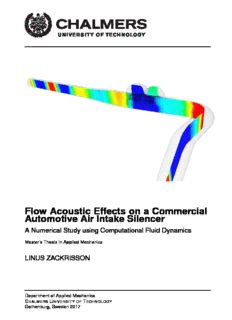
Flow Acoustic Effects on a Commercial Automotive Air Intake Silencer PDF
Preview Flow Acoustic Effects on a Commercial Automotive Air Intake Silencer
Flow Acoustic Effects on a Commercial Automotive Air Intake Silencer A Numerical Study using Computational Fluid Dynamics Master’s Thesis in Applied Mechanics LINUS ZACKRISSON Department of Applied Mechanics CHALMERS UNIVERSITY OF TECHNOLOGY Gothenburg, Sweden 2017 Master’s thesis 2017:76 Flow Acoustic Effects on a Commercial Automotive Air Intake Silencer A Numerical Study using Computational Fluid Dynamics LINUS ZACKRISSON Department of Applied Mechanics Division of Fluid Dynamics Chalmers University of Technology Gothenburg, Sweden 2017 Flow Acoustic Effects on a Commercial Automotive Air Intake Silencer A Numerical Study using Computational Fluid Dynamics LINUS ZACKRISSON © LINUS ZACKRISSON, 2017. Supervisor: Magnus Knutsson, Volvo Car Group Lars Davidsson, Department of Applied Mechanics Examiner: Lars Davidsson, Department of Applied Mechanics Master’s Thesis 2017:76 Department of Applied Mechanics Division of Fluid Dynamics Chalmers University of Technology SE-412 96 Gothenburg Telephone +46 31 772 1000 Cover: Plane acoustic waves seen as difference in acoustic pressure fluctuations propagating in the air intake duct system. Typeset in LATEX Printed by Reproservice/Department of Applied Mechanics Gothenburg, Sweden 2017 iv Flow Acoustic Effects on a Commercial Automotive Air Intake Silencer A Numerical Study using Computational Fluid Dynamics LINUS ZACKRISSON Department of Applied Mechanics Chalmers University of Technology Abstract Noise generated by turbo-compressors in combustion engine air intake systems is often mitigated by broad-band high-frequency duct silencers. The acoustic per- formance of a developed silencer design is generally obtained numerically without influence of duct mean flow, using acoustic computer aided engineering (CAE) tools. Discrepanciesarehowevercreatedbetweentheacousticsoftherealairintakesystem and numerical model of the system since mean duct flow is always present in the real system, due to the aspiration of the engine. This Master’s thesis project aims to capture flow effect on silencer acoustic performance numerically using computa- tional fluid dynamics (CFD). In cooperation with Volvo Car Group, a commercially existing part of an air intake system, including a silencer composed of two Helmholtz resonators, is studied. An already established academic CFD methodology is ex- plored, used, expanded and streamlined to investigate flow effects on acoustic prop- erties of the complex silencer-duct system. The acoustic properties from the CFD simulation are then compared to experimental data and acoustic CAE. The established CFD methodology is integrated and applied using the commercial CFD software Star-CCM+, studying the silencer acoustic behaviour with several mean inlet flow speeds. Using Star-CCM+, mean flow and acoustic wave propaga- tion is simulated simultaneously in the defined computational domain of the given silencer-duct system. Acoustic waves in a frequency band of interest related to the eigenfrequency of the silencer, are inserted through a time-varying inlet bound- ary condition. The numerical setup mimics an acoustic experimental measurement setup where the propagating acoustic waves are captured as pressure signals in vir- tual microphones, to calculate the acoustic silencing property of transmission loss (TL). Turbulence is modelled using the unsteady Reynolds-averaged Navier-Stokes equations (URANS). Numerical parameters in the CFD setup are studied in regards to numerical accuracy and computational efficiency, to find the most optimal model in describing the flow effect on silencer acoustic performance. The most optimal resulting CFD methodology was able to capture transmission loss characteristics with reasonable accuracy, under predicting the resulting eigenfrequency shift with roughly 8.5 % difference for all flow speeds; as well as a 11.4 % transmission loss peak difference, both in comparison to experimental data. Different duct geometrical changes were then studied using the optimally developed CFD setup, in order to improve silencer acoustic performance under flow condition. Through a numerical process, six different geometrical changes were developed with varyingstrategies. Thebestdesignresultedina15%increaseinfirstorderresonance v peak transmission loss and removal of eigenfrequency shift as well as only increasing pressure drop by 1.1 %, in comparison to a reference simulation. Keywords: Computational fluid dynamics (CFD), Aeroacoustics, Air intake si- lencer, Helmholtz resonator, Flow effect, Transmission loss, Noise reduction, Star- CCM+, Unsteady Reynolds averaged Navier-Stokes equations (URANS), geometri- cal change. vi Acknowledgements The presented Master’s thesis project has been conducted in cooperation with the NVH & Driving Dynamics Centre at Volvo Car Group, spring 2017. I would like to express my deepest gratitude towards my supervisor Magnus Knutsson as well as co-worker Simone Vizzini for their continuous encouragement, excellent support and feedback throughout the project. Further, I give thanks to Axel Kierkegaard at Siemens PLM for showing great interest in my project, providing me with valuable information and support regarding Star-CCM+ and CFD. I also want to thank my professor, supervisor and examiner Lars Davidsson at Chalmers University of Technology’s Division of Fluid Dynamics for the interesting discussions regarding the project and valuable feedback. Finally, I want to show my appreciation by thanking all co-workers at the NVH & Driving Dynamics Centre as well as surrounding project groups of interest at Volvo Car Group, it has been a pleasure to work at the office everyday beside all wonderful and friendly people. Linus Zackrisson, Gothenburg, June 2017 viii x
Description: